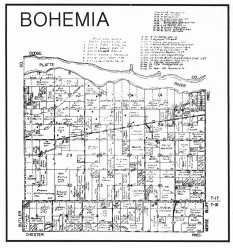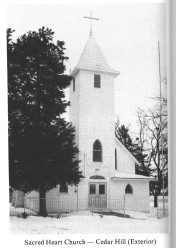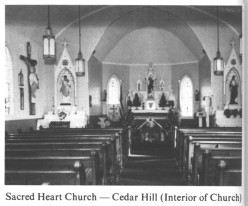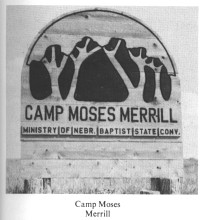 |
| (image links to larger map) |
BOHEMIA PRECINCT
Bohemia Precinct is in the very northwest corner of the county. The Platte R. is its northern boundary. There are spots quite close to the river where many artifacts have been found, in this precinct and neighboring Morse Bluff Precinct. Skull Creek got its name because of the bones found there. These findings (pieces of armor, bones and weapons of war) give much credulence to the belief of the following story:
"Early Spanish records tell of an unlucky expedition into this region of the Platte River. After misusing the Indians, the expedition was wiped out except for a boy and an officer's wife. The Indians managed to capture the horses. The boy grew to manhood among the Indians; he was a hero to them as he taught them to ride and handle the horses, the first horses these Indians had ever had or even seen. The lady bore an Indian child or two before dying."
Bohemia Precinct was created out of Douglas Co. in Feb. 1, 1871. Later, the southern half of the precinct was made into Chester Precinct. On June 2, 1874, the voters of Bohemia presented a petition for the division of their precinct. All south of a line running west on the south side of the north tier of sections in township 16 was made to comprise Chester Precinct. It was ordered at a later time that each voting precinct should constitute a road district.
Bohemia was settled in 1869 by M.R. Noteware and T. Killian. The first post office was established in this section of the county at Sand Creek in 1870, with R. Fleming as postmaster.
Rev. Mr. Kuypers was the first missionary to visit this locality in 1873, preaching in the school house at Cedar Hill. A school district was organized and a school house erected at this point in the early part of 1873. Arthur Brownell was the first teacher. A Catholic mission was formed in 1875.
The Chicago & Northwestern R.R. crosses the precinct from east to west. The land today is excellent farm ground. A strip along the Platte R. to the north is "bluff country." It is very much like the way it was over a hundred years ago. There are scrub oaks and many cedar trees. Many acres are beautiful wild areas used mostly for pastures.
Township officers 1983-87 are: Chairman -- Robert L. Racek, Clerk -- Don A. Chvatal, and Treas. -- Raymond A. Stranik.
HISTORY OF CEDAR HILL AND
SACRED HEART CHURCH
Cedar Hill, Nebraska was originally a post office named Slavonia, established in December, 1872. The name was changed to Cedar Hill on May 12, 1874. Tradition has James H. Noteware naming the area because it was on a hill dominated by cedar trees. Mr. Noteware apparently dreamed of a town in the area, hoping to have the railroad pass near.
Cedar Hill appeared on official maps of Nebraska but the actual town never amounted to more than a general store with the post office inside and a blacksmith shop located across the road, west of the present lodge hall. Mr. Noteware sold land in the Cedar Hill area and helped people settle in there. All that is left today is the church of the Sacred Heart.
The parish was formed in 1879 and the church was built in 1880. After Mr. Noteware's death, his wife carried on the concern for the settlers in the area who were predominantly Czech. Her efforts and donation of land and money helped the dream of a church come true. Her letters to the Bishop of Omaha are on file and describe the trials of the farmers in the areas, the actual delivery of materials for the church, the hope ofa Benedictine Monastery coming to the area, and the completion of the long-awaited church.
 |
| Sacred Heart Church -- Cedar Hill (Exterior) |
The church was well-planned with permanence mind. A 40' x 60' structure was built over a corn field. The corn stalks from the last crop can be seen in the crawl space under the church. Apparently the stalks were burned off since the tops of each stalk are charred. It is interesting to note the size and number of stalks to a mound -- seven to eight stalks, each less than an inch in diameter.
In 1924, the front of the church was enlarged by adding a bell tower and entrance to the west, and a sanctuary and sacristy to the east. It is believed Cedar Hill's Sacred Heart Church is the oldest original Catholic Church still in use. The pioneer people would be proud to know that, unlike other churches that have either burned or have replaced because of inadequacy of size, the original church stands in excellent condition.
 |
| Sacred Heart Church -- Cedar Hill (Interior of Church) |
page 48
KILLIAN'S CEMETERY
Bohemian-Slavonian Cemetery was established about 1870 and was officially known as 'The Czech National Cemetery," but it was commonly called "Killian's Hill Cemetery."
It has been used as a burying place since the above date or possibly a few years earlier.
The location of the cemetery is the Northwest Quarter of Section 23, Township 17, Range 5 in the Bohemia Precinct of Saunders County, Nebraska.
Land belonging to the Cemetery Association consists of a total of 40 acres, of which 3.7 acres are fenced in and maintained as a cemetery.
The following comprise the present cemetery board -- Charles Beranek, president; Francis Chvatal, secretary; Frank Vlasak, treasurer; Ed Franta, George Hynek and Richard Hynek, trustees.
CAMP MOSES MERRILL
A CHRISTIAN GROWTH CENTER
Camp Moses Merrill has been developed by the American Baptist Churches of Nebraska as a Christian Growth Center available to everyone, not only American Baptists in Nebraska.
The 568-acre site overlooking the Platte River has a cabin area, a family camping area, and many acres of unspoiled bluffs ideal for hiking and nature study. The ten cabins and dining hall can easily accomodate 100 people year around, and the 75 camper pads and tent sites are augmented with numerous activities including swimming, tennis, archery, cross-country skiing, horseshoes, and volleyball.
The camp exists to serve the Camp and Conference Program of the American Baptist Churches of Nebraska. The cabin area of Camp Moses Merrill is used ten weeks each summer for their Youth Camping Program.
 |
Camp Moses
Merrill |
Camp Merrill, originally located near Fullerton Nebraska, was relocated to Bohemia Township in Saunders County in 1976 after purchasing the land in 1972. It was named in honor of Moses and Eliza Merrill who were Nebraska's first American Baptist Missionaries and teachers for the Native Americans, from 1833 to 1840.
Current staff on site includes; Manager, Pat and Julie Moore, sons Zach, Luke; Assistant Manager, Elwin and Bonnie Stevenson, daughter Robin. Submitted by Pat Moore
page 49
| 
